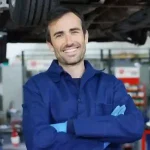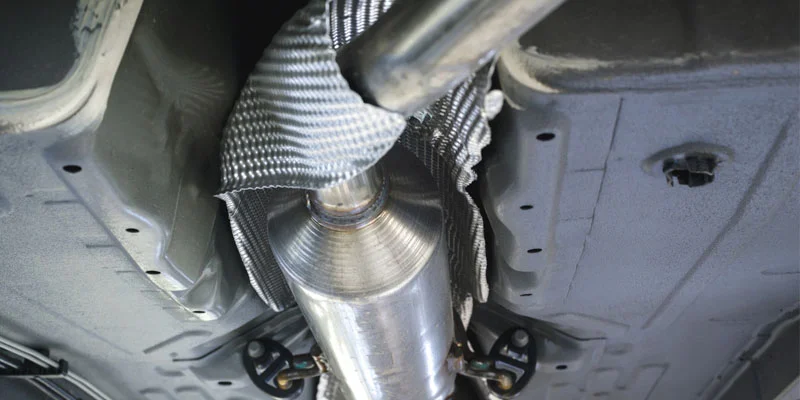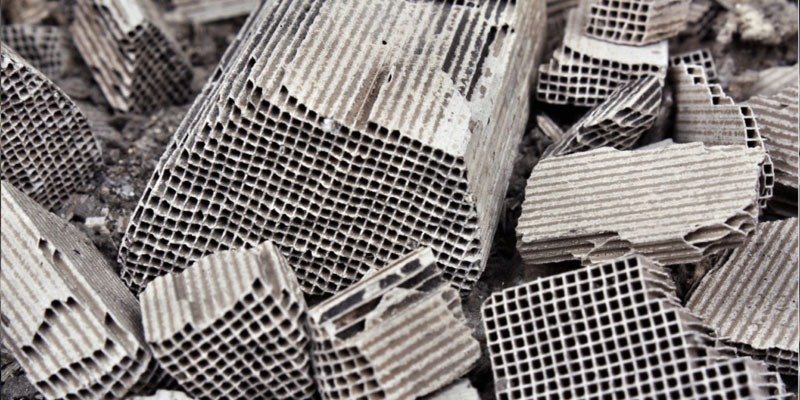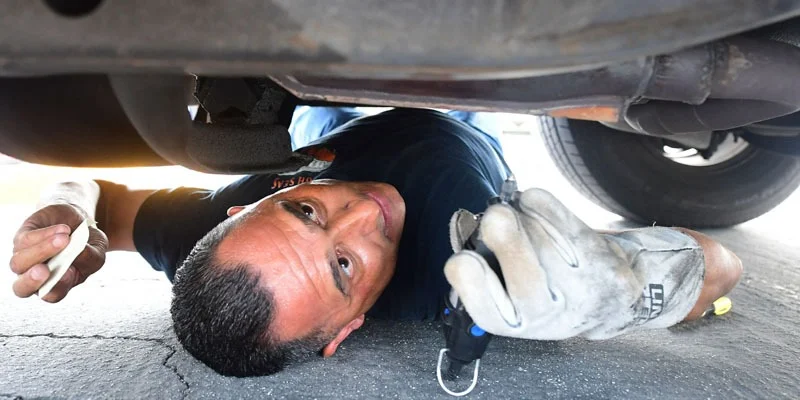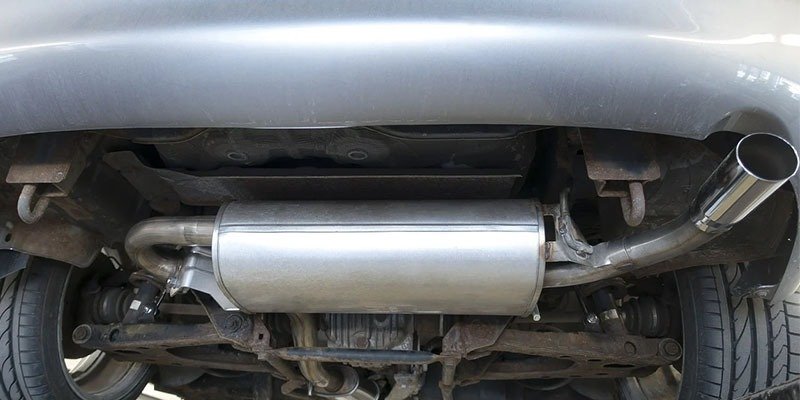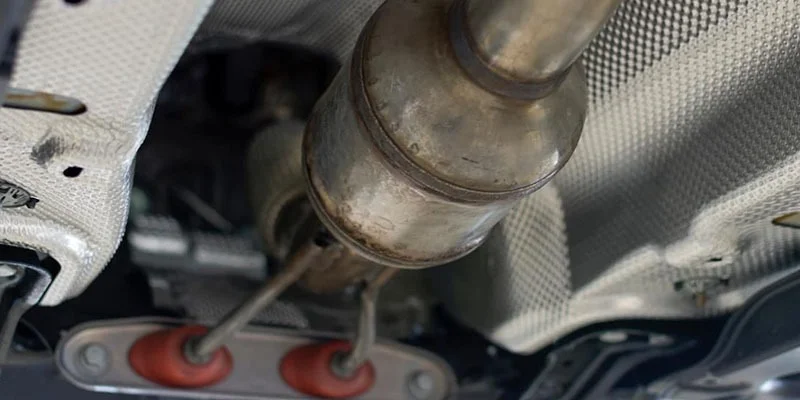Catalytic converters are a crucial component of a vehicle’s exhaust system, as they reduce harmful emissions that would otherwise be released into the environment. Over time, catalytic converters can become clogged with various contaminants, including oil, dirt, and carbon deposits, leading to decreased performance and efficiency.
Can a clogged catalytic converter be cleaned? Yes! You can successfully clean the clogged catalytic converter with this guide.
Why is it essential to clean catalytic converters?
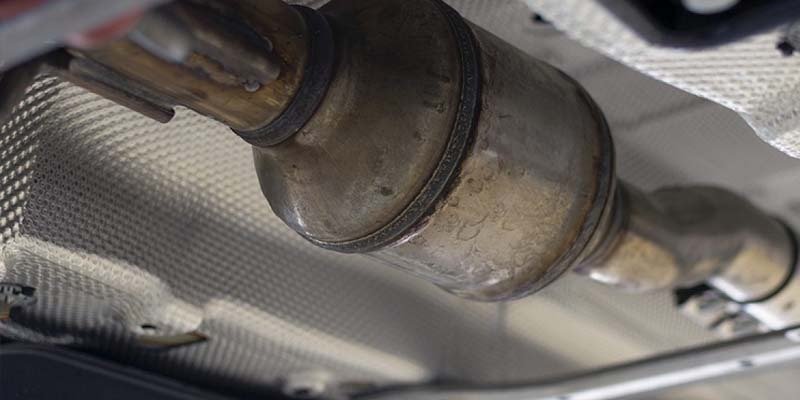
When a catalytic converter is clogged, it can cause a decrease in engine power and fuel efficiency, as well as trigger a check engine light. A clogged catalytic converter can also emit harmful pollutants into the environment, negatively impacting air quality and public health.
To keep a catalytic converter functioning correctly, it is essential to have it cleaned regularly, either by a professional mechanic or a catalytic converter cleaner. Cleaning the converter can restore its performance and efficiency and reduce harmful emissions. Additionally, keeping a catalytic converter clean can help extend its lifespan, as clogged converters are more likely to fail sooner than properly maintained ones.
6-Step Strategy to Clean Catalytic Converter (By Removing It)
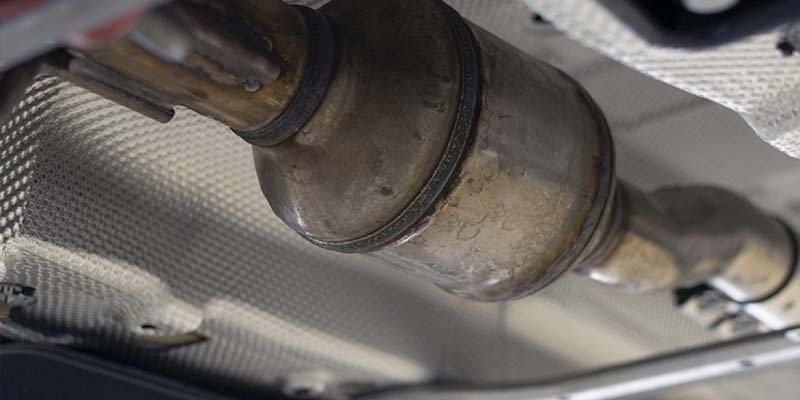
Here is the detailed guide on how to clean catalytic converter:
1. Gathering Tools and Supplies
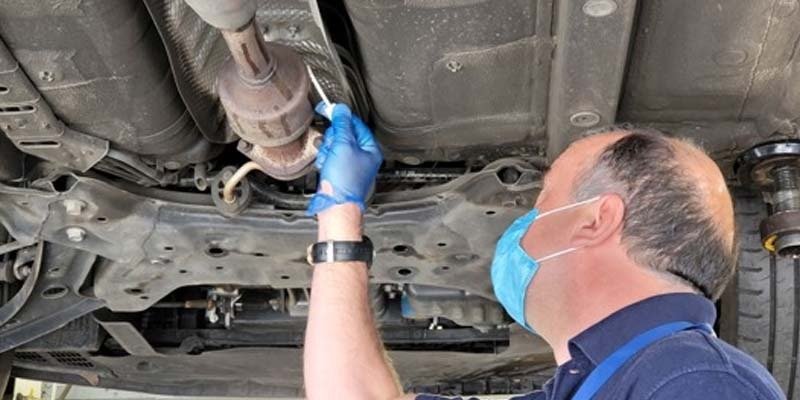
A. List of tools and supplies needed
When cleaning the catalytic converter, it’s essential to have the right tools and supplies. Here’s a list of what you’ll need:
- Catalytic converter cleaner
- Plastic gloves
- Safety glasses
- A flat-head screwdriver
- A socket wrench set
- A metal wire brush
- A bucket
- A dry towel
B. Importance of safety precautions
Safety should always be a top priority when working on your car. When cleaning the catalytic converter, it’s essential to take the following precautions:
- Wear gloves to protect your hands from chemicals and hot surfaces.
- Put on safety glasses to protect your eyes from debris and harmful chemicals.
- Make sure the engine is excellent before attempting to clean the catalytic converter.
- Avoid using a metal wire brush on hot surfaces, as this can cause sparks and start a fire.
- Read and follow the instructions carefully when using catalytic converter cleaner.
- Avoid inhaling fumes from the cleaner.
By following these safety precautions, you can minimize the risk of injury and damage to your car while cleaning the catalytic converter.
2. Identify the location of the Catalytic converter

The catalytic converter is an essential component of a vehicle’s exhaust system, and it’s usually located between the muffler and exhaust manifold. It’s a small, cylindrical-shaped part that sits under the car, and it’s often made of metals such as platinum, palladium, and rhodium, as well as ceramic material.
Knowing the location of the catalytic converter is essential for several reasons. First, it makes it easier to clean the part and perform regular maintenance on it. Second, if you suspect your catalytic converter is clogged or damaged, being familiar with its location can help you diagnose the problem more quickly.
3. Steps to remove the Catalytic converter
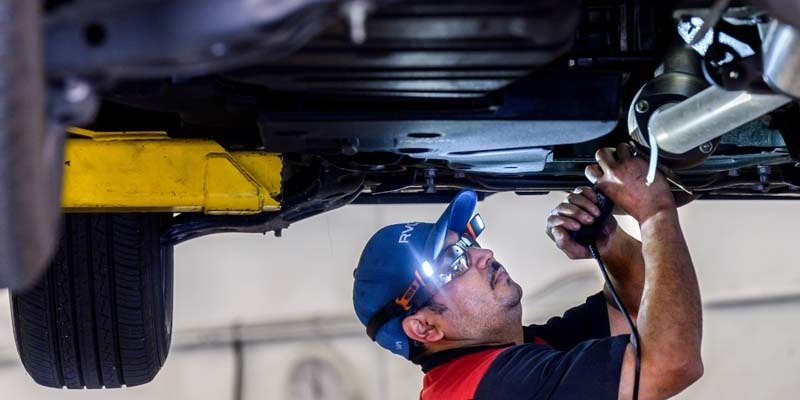
Removing the catalytic converter from a vehicle can be a complex process and should only be attempted by individuals with the proper training and tools. You should only use this method if you have previously unscrewed any part of your car. Here is a general step-by-step guide for removing the catalytic converter:
- Raise the vehicle: Use a jack to lift the car off the ground, so you have enough room to work underneath it.
- Locate the catalytic converter: It is typically located under the vehicle between the engine and the muffler.
- Disconnect the exhaust system: Locate the exhaust pipe that connects to the catalytic converter and disconnect it.
- Remove the bolts and nuts: Look for the bolts and nuts that secure the catalytic converter to the exhaust pipe. Remove them using a socket wrench.
- Remove the catalytic converter: Once the bolts and nuts have been removed, gently pull the catalytic converter away from the exhaust pipe.
- Replace the gasket: If necessary, replace the gasket that seals the connection between the catalytic converter and the exhaust pipe.
Tips to help ensure a safe and successful removal
It is essential to be careful during removal to avoid damaging the catalytic converter or exhaust system.
- Wear protective gear: Wear gloves, eye protection, and a mask to protect yourself from harmful chemicals or debris.
- Be gentle: Handle the catalytic converter with care to avoid damaging it. If it is stuck, try gently tapping it with a rubber mallet to loosen it.
- Follow the correct procedure: Follow the proper steps for your specific vehicle to ensure that the catalytic converter is removed safely and correctly.
- Dispose of the catalytic converter properly: Catalytic converters contain precious metals and should be disposed of in an environmentally responsible manner. Check your local regulations for proper disposal methods if the catalytic converter is worn out.
4. Cleaning the exterior of the catalytic converter
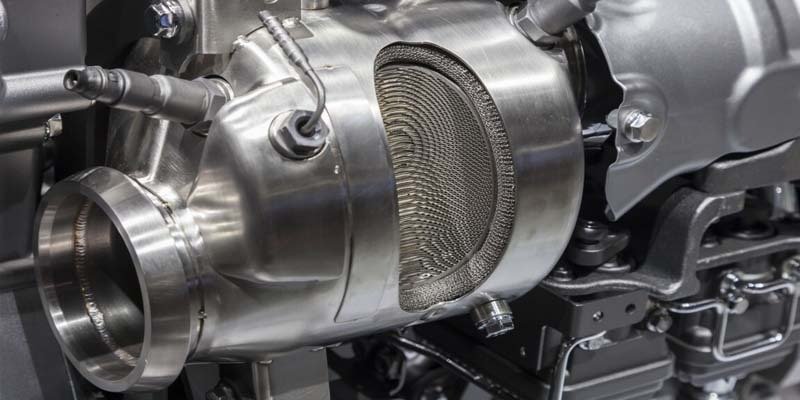
Cleaning the exterior of the catalytic converter is essential for several reasons:
- Protection against rust and corrosion: Dirt, grime, and other debris can trap moisture against the surface of the catalytic converter, leading to rust and corrosion over time.
- Improved performance: A dirty catalytic converter can impede exhaust gas flow, reducing the vehicle’s performance.
- Improved appearance: A clean catalytic converter will give the vehicle’s undercarriage a cleaner and more well-maintained appearance.
Detailed instructions for cleaning the exterior of the catalytic converter:
Prepare your cleaning supplies: You will need a soft-bristled brush, a bucket of warm water, a gentle cleaner such as dish soap, and a high-pressure water source such as a hose or pressure washer.
- Spray the catalytic converter with water: Use a high-pressure water source to rinse the exterior of the catalytic converter, removing any loose dirt or debris.
- Mix the cleaner: Fill the bucket with warm water and add a small amount of the gentle cleanser. Stir the mixture to create suds.
- Use the soft brush to clean the surface: Dip the soft-bristled brush into the cleaning solution and use it to scrub the exterior of the catalytic converter. Be gentle to avoid damaging the surface.
- Rinse the catalytic converter: Use the high-pressure water source to rinse the catalytic converter’s surface, removing all the cleaning solution and suds.
- Dry the catalytic converter: Use a clean cloth or let the catalytic converter air dry.
- Inspect the surface for any remaining dirt or debris: If necessary, repeat the cleaning process until the exterior of the catalytic converter is thoroughly cleaned.
- Dry it completely before reinstalling: It is crucial to dry the converter using a dry cloth before reinstalling.
5. Step-by-step instructions for Reinstalling the catalytic converter

Gather necessary tools and materials: You will need new gaskets, exhaust sealant, a torque wrench, and a jack and jack stand.
- Clean the mating surfaces: Clean the mating surfaces of the exhaust pipes and the catalytic converter to ensure a proper seal.
- Apply sealant: Apply a thin layer of exhaust sealant to the mating surfaces of the exhaust pipes and the catalytic converter.
- Install the new converter: Place the new catalytic converter into position and align the flanges with the exhaust pipes.
- Install the gaskets: Install the new gaskets between the catalytic converter and the exhaust pipes.
- Tighten the connections: Use a torque wrench to tighten the connections between the catalytic converter and the exhaust pipes to the specified torque.
- Test the system: Start the engine and test the exhaust system for leaks or issues.
B. Importance of tightening all connections securely:
It is important to tighten all connections securely to ensure a proper seal and prevent exhaust leaks. Exhaust leaks can reduce the performance of the catalytic converter and increase emissions. Also, leaks can create a fire hazard and cause damage to the surrounding parts of the vehicle. By tightening all connections securely, you can ensure the proper functioning of the catalytic converter and maintain a safe and efficient vehicle.
6. Testing the Vehicle
A test drive is necessary after installing a new catalytic converter or making any changes to the exhaust system to ensure that the vehicle is operating correctly and that the catalytic converter is functioning as expected. During the test drive, you can check for issues such as decreased performance, excessive emissions, or unusual noises. A test drive can help identify any problems that need to be addressed before they become more severe and expensive to repair.
B. Detailed instructions for taking a test drive:
Warm up the engine: Start and let it warm up for a few minutes to ensure that all systems are functioning correctly.
- Check for leaks: Look for any visible signs of exhaust leaks, such as smoke or fumes. If you notice any leaks, stop the vehicle and address the issue before proceeding with the test drive.
- Check the gauges: Before you start driving, check the gauges to ensure that all readings are within normal operating range.
- Drive at different speeds: Drive the vehicle at a variety of rates, including slow, medium, and high speeds, to check for any performance issues.
- Listen for unusual noises: Any unusual noises that may indicate a problem with the catalytic converter or the exhaust system.
- Check the emissions: Check the emissions by observing the tailpipe for excessive smoke or fumes.
- Check the performance: Check the overall performance of the vehicle, including acceleration, power, and fuel efficiency.
- Document your findings: Document your results from the test drive, including any issues you noticed and the conditions under which they occurred.
Note: If you notice any issues during the test drive, it is best to have the vehicle inspected by a professional mechanic. They can diagnose the problem and make necessary repairs to restore the proper functioning of the catalytic converter and the vehicle.
The method suggested above requires automobile repair know-how. If you need more clarification about the uninstallation and reinstallation of the catalytic converter, you can try cleaning without removing the catalytic converter.
Cleaning without Removing Catalytic Converter – Method 2
Add a catalytic cleaner additive to your gas tank. You can research the best cleaner additive for your car online based on your engine type, model, and make. At the same time, some cleaners are meant explicitly for petrol engines while others may be devised for the gasoline of diesel engines.
While some cleaners may require more gas, the standard rule to add cleaner additives is 15L of gas in the tank. If the gas level goes below and the check light appears, add more gas to the tank before adding the cleaner.
Now check the labels of the cleaner to understand how much quantity is to be added. Once you add the cleaner, it will mix with the gas and run through the catalytic converter while driving.
Drive the car generally until the fuel tank goes empty. You may notice that the engine starts running smoothly. It is recommended to drive over 3000 RPM so that.
However, this method is unsuccessful when the catalytic converter is highly clogged.
Frequently Asked Questions
Does cleaning a catalytic converter work?
The catalytic converter cleaning works only for clogged converters. If the catalytic converter is worn-out or damaged, cleaning will not help. Moreover, cleaning the converter y damage the internal catalyst.
How long can a car run with a clogged catalytic converter?
Technically, you can drive your car infinitely with a clogged catalytic converter. But it is not recommended as it will drastically hamper your car’s performance. Moreover, your car will release unprocessed exhaust gas and eventually fail the emission test.
What are the signs of a clogged catalytic converter?
Some prominent signs of a clogged catalytic converter are dark exhaust smoke, the smell of rotten eggs, extreme heat under the vehicle, slow powertrain performance, and reduced acceleration.
Will premium gas help clean the catalytic converter?
No! The premium gas does not help with any catalytic converter cleaning. It only helps with increased efficiency and performance.
Will seafoam clean a catalytic converter?
No, Seafoam is not effective at cleaning the catalytic converter. However, it keeps the fuel system clean and avoids building up on the O2 sensors.
How can I prevent my catalytic converter from clogging?
An occasional drive to the highway with more than 3000 RPM for around 15 minutes helps heat and burn down all the build-up in the catalytic converter.
Does redex clean catalytic converters?
Redex is safe for petrol and hybrid engines to clean the catalytic converters.
Can a clogged catalytic converter hurt your engine?
Clogged converter results in sluggish engine performance in the shorter run, and finally, the engine shuts down in the long run if the problem is not addressed in time.
Is it better to clean or replace the catalytic converter?
Cleaning the catalytic converter is the most cost-effective solution. However, if you notice some rattling sound inside the catalytic converter, it is an indicator that the converter is damaged. The cleaning trick will not work in this case. You have to replace it with a new catalytic converter.

My Name is Christopher Angels, and I am a postgraduate in mechanical engineering. Cars have always excited me as a child, and soon I decided to dive into the world of cars by pursuing mechanical engineering. I also worked as a Mechanic for over 3 years to understand Cars’ anatomy and how each part contributes to its working.
My Name is Christopher Angels, and I am a postgraduate in mechanical engineering. Cars have always excited me as a child, and soon I decided to dive into the world of cars by pursuing mechanical engineering. I also worked as a Mechanic for over 3 years to understand Cars' anatomy and how each part contributes to its working.


